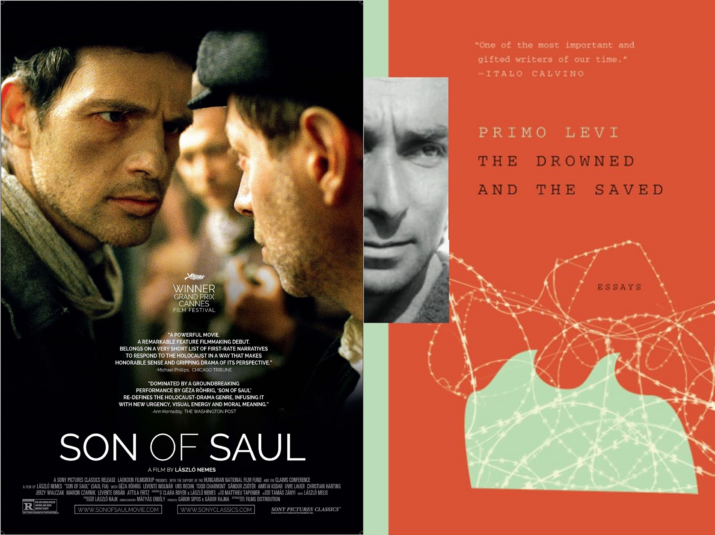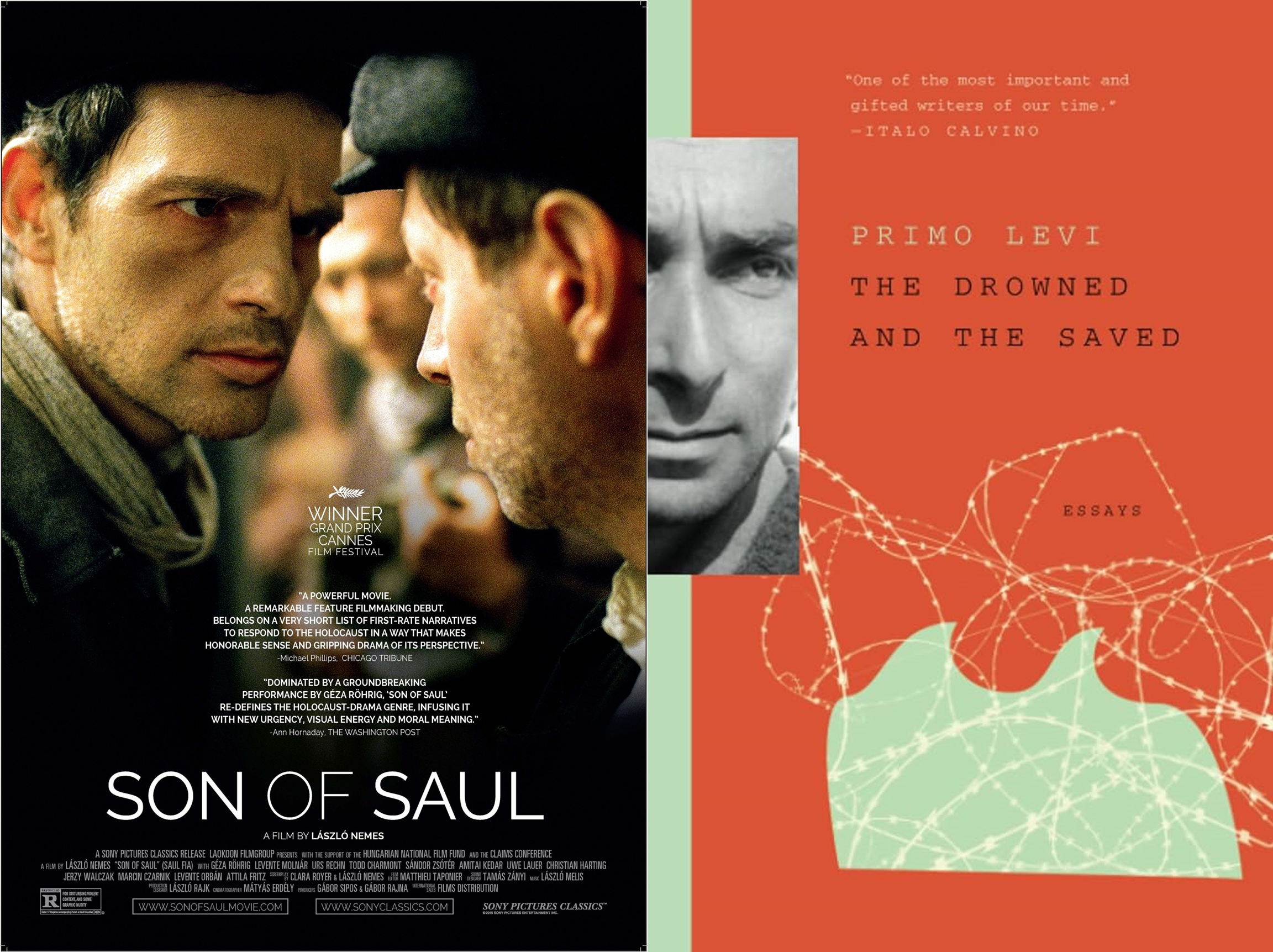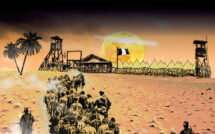
The Drowned, the Saved, and the Sonderkommando: A Lesson Plan for Teaching Son of Saul and Primo Levi in Tandem
 Course description
Course description
This lesson plan is modified from an advanced undergraduate/graduate history course titled The Holocaust. The first half of the course introduces students to Jewish life in early twentieth-century Europe, Germany’s interwar embrace of Nazi fascism, the hardening of the Nazi state, and the early Nazi and allied prosecution of the racial war in Germany itself and in Eastern Europe. The second half of the course focuses on Holocaust as it unfolded in the Second World War, with a special focus on the Final Solution to the Jewish Question as prescribed at the Wannsee Conference, i.e., the mass gassing of Europe’s remaining Jews through a system of six camps in part or in total designed for that sole purpose. During the last few weeks of the semester, the class examines the Final Solution through two sources: László Nemes’ 2015 film Son of Saul and Primo Levi’s 1986 essay collection The Drowned and the Saved.
Son of Saul follows Saul Ausländer (German for “alien” or “foreigner”) over the final two days of his life. As a member of the Auschwitz-Birkenau Sonderkommando, he is charged with escorting Jewish transports to the gas chambers, removing the corpses, or Stücke (English: “pieces”) after the Zyklon B haze has cleared, stripping the corpses of valuables, and spreading the ashes of the murdered. After one of these gassings, Saul notices a young boy who has miraculously survived. A Nazi doctor quickly kills the choking but unconscious child. Saul claims the boy as his son and makes it his mission to give him a proper burial. His continued work around the gas chambers, his involvement and almost foiling of the October 7, 1944, Sonderkommando Uprising, and his pursuit of a rabbi to oversee the internment of his “son” constitute the remainder of the story. A uniquely jarring piece of Holocaust fiction, Son of Saul is the only non-documentary or primary source film students watch the entire semester. Therefore, I provide students with a set of viewing guidelines, included below.
After viewing, writing about, and discussing the film, students also read and discuss several chapters from The Drowned and the Saved. Unlike Levi’s first and most famous memoir, Survival at Auschwitz, The Drowned and the Saved captures the survivor, chemist, and writer’s more developed and philosophical meditations on his and others’ experiences of the concentration camp system. It is sophisticated, nuanced, and, at times, uncomfortably trenchant. Published forty years after the first run of Survival in Auschwitz, it is also Levi’s final publication before his death in 1987. Although students read excerpts from other testimonies and memoirs during the semester, this is the only survivor’s account that students read at length.
Step 1: Son of Saul (Part I)
Student directions for homework
Read the Guidelines for Watching Son of Saul handout (see below) and watch the film.
Then, respond to this prompt: Choose two particularly impactful or important scenes from Son of Saul. Explain when in the film the two scenes occur and analyze them. What is the setting? What happens in the scenes and how does the action fit in with themes we have discussed in class? What makes these scenes so impactful? How do they fit in with the rest of the film’s narrative? Reaction papers should be at least 300 words.
Instructor directions for class meeting
The next class meeting is devoted to discussing Son of Saul in its historical context.
Steps:
- Begin class with an excerpt from the film to give students a chance to get in the appropriate mindset. Walk students through the first several minutes of the film, wherein Saul, a member of the Sonderkommando (special command unit), ushers a transport of Jews to the gas chamber. Point out the lay of the camp itself (especially if you have previously examined pictures of Birkenau), the differing roles of prisoners, the Schutzstaffel (SS) guards, the various languages heard and the non-verbal modes of communication displayed. Alternately, one can allow László Nemes, himself, to walk students through the first several minutes of the film through this “Anatomy of a Scene” video from The New York Times.
- Start the discussion. This can take place in small groups or as an entire class if enrollment is small enough. Either way, it helps to display a map of Birkenau on the board or a still from the film to facilitate discussion and help students locate where events took place. Potential discussion questions are listed on the “Guidelines for Watching Son of Saul” sheet.
- The final questions (“What does the film say about resistance and maintaining one’s humanity amidst such inhumanity and brutality? What does it say about moral order in such conditions?”) offer the opportunity to transition to Primo Levi’s concept of the “gray zone.”
Step 2: The Drowned and the Saved (Parts II-III)
Part II
Student directions for homework
Read: Preface, Chapters I-III (The Memory of the Offense, the Gray Zone, Shame), About the Author (near the back of the book) in The Drowned and the Saved.
Instructor directions for class meeting
For the first half of class, introduce Primo Levi and Italian Jewish experiences of early twentieth-century Europe and the Shoah.
For the second half, discuss as a class or in small groups the meaning of Levi’s concept of the gray zone (found in “Chapter II: The Gray Zone”) and how it relates to Son of Saul. Again, project a choice still image from the film, or a historical photograph to give students a visual point of reference if necessary. If time remains, address Levi’s analysis of shame and violence in the camps. If not, address this the following class.
NB: In the interest of time, one could follow the film discussion with a class devoted solely to Levi’s essay, “The Gray Zone,” which addresses dehumanization through the constant moral compromises the Nazi extermination camps forced upon their victims, or “Stereotypes,” which refutes several common assumptions about resistance, heroism, and survival in the camps.
Part III
Student directions for homework
Read: Chapters IV (Communicating), V (Useless Violence), VII (Stereotypes), and Conclusion in The Drowned and the Saved.
Instructor directions for class meeting
Reintroduce the concept of the gray zone. Field any remaining questions or comments on it. Ask whether students find it compelling and how it relates to what they know of resistance, uprisings, and partisans, if you have covered these topics previously.
Then, discuss as a class or in small groups Levi’s writings on shame, useless violence, stereotypes, resistance and survival using Son of Saul as a reference point. This works especially well for Levi’s writing on useless violence and stereotypes of the heroic will. A still from the film, a historical photograph, or a presentation on another camp experience may facilitate these discussions.
To close the unit, end the discussion in class and reintroduce it on a final exam. Alternately, one could assign a paper wherein students explore one of these themes in The Drowned and the Saved and Son of Saul at length.
Guidelines for Watching Son of Saul
Son of Saul is the 2015 film by Hungarian direction László Nemes. The action follows a member of the Auschwitz Sonderkommando, Saul Ausländer (Géza Röhrig), in his quest to give a proper burial to a young boy he discovers while clearing out a gas chamber. The historical backdrop is October 1944, on the fringe of the Warsaw Uprising (not mentioned in the film), the Soviet advance into the General Government from the east and, more immediately, the Sonderkommando Uprising at Crematorium IV on October 7.
Normally, when watching a film like this, you simply sit back and watch. Since completing this film necessitates a critical “reading,” however, I offer some information and guidelines to get you started.
- Watch from a comfortable seat, on a big screen with the best sound system at your immediate disposal. Do not fiddle with your email and put your phone away.
- Take notes! Write down observations, partially developed thoughts, important scenes and events with corresponding times/locations, questions, or, really, anything relevant you feel like writing down. Doing so will help you write your film reflection. It will also help you make sense of the film later.
- Pay attention to cinematic techniques. Are shots long, short, or medium? Are the shots smooth or stilted? Is the effect relaxing, exciting, disorienting?
- Also, pay attention to the anatomy of scenes. Read them as you would a page in a book or a still photograph. What is in the foreground and background? What is pictured? Is something not pictured, but still present? What colors are used? What lighting? Is the shot centered on something in particular? Is it clear or blurry? Does it play with tropes? In other words, what story does a scene tell within the plot, and as a “painting” in its own right?
- Pay particular attention to the beginning and the end. That applies to the credits as well as the opening and closing scenes, which often can be read in relation to each other.
- Watch for repetition and one-off events that seem particularly important. Watch closely when the camera lingers, especially when it seems the scene should be over by that point.
- Watch actively and draw connections constantly. Many of these connections may seem tenuous as the film moves on. All hunches are not correct. That said, some will be and may lead to important and unique insights.
- Pay close attention to characters. Do not be too hard on yourself if you forget a name every now and then. These names will recur throughout the film and, if you still forget, you can always consult IMDB or another resource to verify. That said, as the film moves forward, you want to recognize who says and does what.
Those are important techniques to unlocking a scene or storyline. Here are some questions more tailored to Son of Saul. Ponder these as you watch the film.
- Saul’s last name is Ausländer, which means “foreigner” in German. To what is he foreign?
- From whose perspective is the film shot? How does this affect the viewer’s experience?
- When does the film’s action take place and how long does the film’s action last? What do we know about this period historically?
- How many languages can you pick out and in which scenes? Why are there so many? How do prisoners communicate with each other? With guards? How many languages does Saul speak and how might these specific languages have helped or hindered his temporary survival?
- How are social ties constructed, maintained, and broken among the prisoners and/or among the members of the Sonderkommando specifically?
- What role does clothing play in the story? How does this reflect one’s station? How utilitarian is it? Are there qualitative differences between the clothes, for instance, that the new arrivals are wearing and forced to surrender on the one hand and the clothing worn by the Sonderkommando on the other? Are there differences within their ranks?
- In a given scene, where are the KL (Konzentrationslager, concentration camp) guards? Are they always present? When are they not and what does this tell us about the functioning of the day-to-day operations of a death camp like Auschwitz-Birkenau?
- What is the plot and why is it so hazy so much of the time? Does it always drive the action? And now for a leading question, how much of a plot can exist under these conditions? Wherein lies individual agency?
- How does action in the plot impact the historical setting or the course of actions outside of that immediate plot?
- What does the film say about resistance and maintaining one’s humanity in the midst of such inhumanity and brutality? What does it say about moral order in such conditions?
Nicholas Ostrum received his PhD in history from Stony Brook University in 2017. He is currently an assistant professor at Kent State University and has been a member of EuropeNow’s Research Editorial Committee since the journal’s inception. Since 2021, he has also served as co-chair of the Critical European Studies Research Network at the CES. He has published articles, reviews, and pedagogical pieces in numerous journals, including The International History Review, The Journal of World History, and, of course, EuropeNow. He also contributed a chapter to the collected volume, After the Imperialist Imagination: 25 Years of Research on Global Germany and Its Legacies (Peter Lang, 2020).
References
Levi, Primo. The Drowned and the Saved: Essays. New York: Simon and Schuster, 2017.
Murphy, Mekado. “Anatomy of a Scene: Laszlo Nemes Narrates a Scene From ‘Son of Saul.’” The New York Times, January 21, 2016: https://www.nytimes.com/video/movies/100000004159787/anatomy-of-a-scene-son-of-saul.html.
Nemes, László, dir. Son of Saul. Culver City, CA: Sony Pictures Home Entertainment, 2016.
Published on November 21, 2023.




